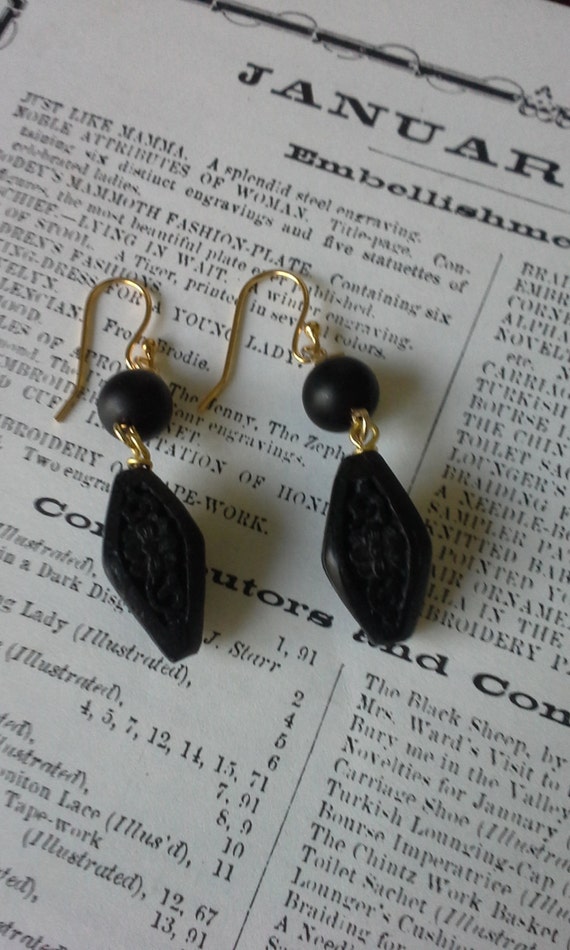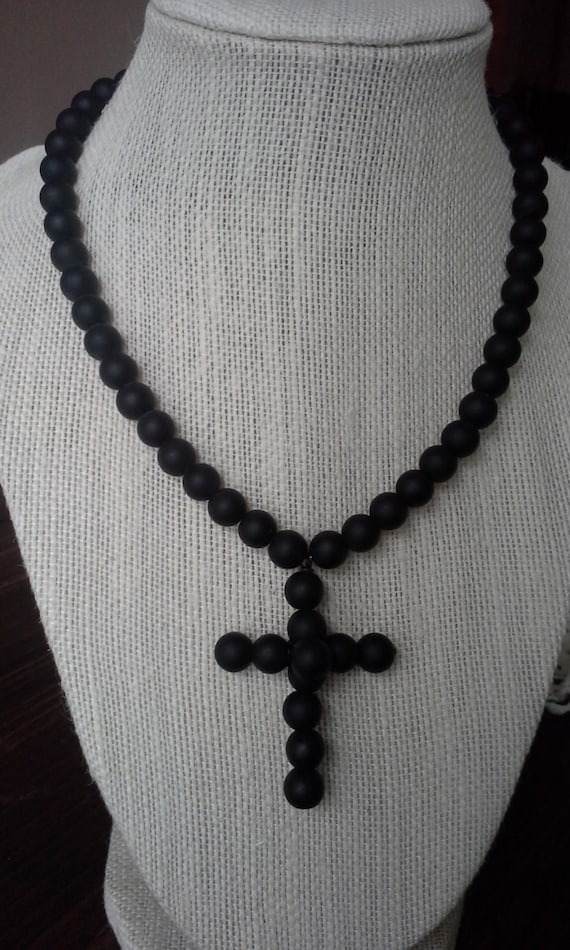For my pre-history lesson, I'll remind the reader that in 1861, Queen Victoria lost her husband Albert. She launched herself into a perpetual state of mourning. Fashion followed her icon! An explosion of dark stone jewelry overtook the collarbones and wrists of the Victorian lady. Bog oak, gutta percha, jet, vulcanite...all could fit appropriately for some form of mourning. And since America mimicked European/English fashion, we tagged along!
From 1861 and onward, black became quite fashionable. Clothing and jewelry seemed to reflect this change the most. The mourning would continue until Queen Victoria's death in 1901. Her beloved Albert's death in 1861 would shape the evolution of style for a century to come.
History
According to Google, bog oak is defined as "an ancient oak tree that has been preserved in a black state of peat." This can be pine, oak, or yew. Bog wood can be found throughout the world, but in terms of 19th century jewelry, it really came from Ireland. This explains the Irish motifs of abbeys, castles, shamrocks, and religious motifs often found in the jewelry.The industry for bog oak ornaments began in the early 19th century. Patrick M'Guirk, a goldsmith and jeweler, presented a carved walking stick to George IV of England. His design was greatly admired, and others soon began working with bog oak. By the Great Exhibition of 1851, the craft became a well-known craft of Ireland. It's popularity really exploded after Queen Victoria's husband died in 1861, making all of the dark stone jewelry a must-have thing.
Bog oak was also used as a building material. One can find furniture dating back hundreds of years utilizing the material. It looked nice and was fairly easy to work with.
Historical speaking, there is quite a bit of evidence proving the existence and use of bog oak during the 19th century. In terms of jewelry? Well...
Photographic Evidence
One of the usual problems I run into concerning photographic evidence...just what in the heck am I looking at? Is it bog oak? Gutta percha? A splotch of ink dropped by a careless relative? Time can be cruel to such items, and photography was still a new craft. Here's a few that might be it...
It's so hard to tell! I searched for jewelry that had more of a dull texture, but that requirement could apply to vulcanite. At the very least, we can see that it is worn by women of different ages and in different contexts. Brooches, bracelets, and earrings could all be made from bog oak. While the evidence is a bit grainy, it is enough to establish that such jewelry existed on women during that time.
Textual Documentation
FOURTH ANNUAL REPORT OF THE ROCHESTER LADIES' ANTI-SLAVERY SOCIETY.
FREDERICK DOUGLASS' PAPER. January 19, 1855.
Among the contributions from Cork, greatly admired, was the choice and rare assortment of bracelets. Those manufactured of fish-bone, and bog-wood , always sell; indeed, the fijouterie from Cork is generally well disposed of.
National Anti-Slavery Standard. January 27, 1855
The Bristol Box included very beautiful articles from Frenchay, Chatham, Ilsminster and Southampton, and a variety of pretty things, patch work, toys, &c., contributed by the children of St. James's Back Ragged School, the Kingswood Reformatory School, Levins’ Mead Boys’ Sunday School, Levins’ Mead Girls’ Daily School, and the Blind Asylum. The pretty baskets from the latter were disposed of at once. Dublin furnished a most elegant and abundant assortment, rich in Afghan blankets, embroidered table covers, papier-maché, bronzes, purses, elegant cushions, the prettiest of smoking caps, ornaments in bog oak, crochet collars, an arbutus wood backgammon board that was greatly liked, and such an immense variety of little articles as we cannot enumerate.
THE TWENTY-FIRST NATIONAL ANTI-SLAVERY BAZAAR.THE LIBERATOR. January 26, 1855
Dublin furnished a most elegant and abundant assortment, rich in Afghan blankets, embroidered table covers, paper mache, bronzes, purses, elegant cushions, the prettiest of smoking caps, ornaments in bog oak , crochet collars, an arbutus wood backgammon board that was greatly liked, and such an immense variety of little articles as we cannot enumerate.
Frank Leslie's Weekly. March 17, 1860
IRISH Bog-Oak Bracelets, Brooches, Ear-Drops, Pins, &c.
SWISS Carved Fancy Boxes, &c., from London Exhibition.
AMERICAN Indian Beads and Barkwork, Feather Fans, &c.
GERMAN Fancy Articles for the Holiday sales.
Frank Leslie's Weekly, APRIL 5, 1862
THE Irish “Bog Oak ” has been long known and celebrated. It consists of the fallen trunks of ancient oak forests, now deeply covered by accumulations of peat bog, but still perfectly sound. This ancient wood furnishes large quantities of valuable timber, which is mined from the beds in which it lies, and worked into beautiful articles of cabinet work, sculptured panels and other carving. The dark stain imparted to it by the long steeping it has undergone in water saturated with both vegetable and mineral matters, gives it a special value for ornamental wood work. Similar deposits of ancient wood exists in the vast swamps of New Jersey. These buried trees, however, are cedars and not oaks, and it is made a regular and profitable business to dig them from their beds, to be manufactured into shingles, which are said to be of exraordinary excellence and durability. A New York paper thus describes the timber and the process of getting it out: “These swamps are very valuable, an acre of such timber commanding from $500 to a $1,000. A peculiar feature of the swamps is that the soil is of purely vegetable growth, often 20 feet or more in depth. The peaty earth is constantly accumulating from the fall of leaves and boughs, and trees are found buried in it at all depths, quite down to solid ground. The timber so buried retains its buoyancy and color, and large numbers of workmen are constantly employed in raising and splitting the logs into rails and shingles. In searching for these logs, the workmen uses an iron rod, which he thrusts into the soil, and by repeated trials, ascertains the size and length of the wood he strikes, and then, by digging down, obtains a chip, by the smell of which he can determine whether it is worth removal. The number of shingles produced from the wood of these submerged forests is very great; from the little town of Dennisville, in this county, as many as 800,000, valued at $12,000 have been sent to market in a year. From the same place, thousands of dollars worth of white cedar rails are annually sent out. The deposit of timber at this point extends to an indefinite depth, and although, from the growth above it, believed to be 2,000 years old, is all entirely sound, and will supply, for years to come, the draft upon it.”That last reference describes bog oak as "celebrated." Interestingly enough, fashion magazines such as Godey's Lady's Book or Arthur's Home Magazine do NOT mention bog oak in terms of jewelry. Of course magazine heroines survive the treacherous "bog," or use it for their plants. But it seems my only references are found in terms of sale. What does this mean for bog oak jewelry? We know it was bought/sold in terms of jewelry, as noted by "Bog-Oak Bracelets, Brooches, Ear-Drops, Pins." I find this lack of evidence in fashion magazines to be quite intriguing!
It is incredibly difficult to date this jewelry, as many of these styles continued through the 19th century. I couldn't find many examples of bog oak jewelry, or perhaps as many as I assumed. Is it because the wood deteriorates at a different rate than other materials? Or was it not considered as important to save as some of the other jewelry? Does it truly matter because it's all gorgeous stuff?
Conclusion
While I collected enough evidence to prove that bog oak certainly adorned the 19th century lady, I was surprised by the amount. Why isn't there more? Why don't fashion magazines publish articles about bog oak? Or was it considered more of a novelty? I love when I leave a post with more questions than answers. It makes me think more deeply about my research, and where it could go!I do have a few pieces in my shop that emulate that bog oak feel. My reproductions of bog oak are typically made with clay, as it can have a similar matte appearance. I'm also particularly proud of the cross; made with a matte onyx bead, I have found plenty of documentation for that particular style of jewelry. Since bog oak is precious, I lock away my originals rather than wear them. I'm a jewelry accident waiting to happen...
While writing about bog oak, the heaping pile of research has inspired me for my next "dwelling in the primary sources" article. It will be a bit of a mystery, one that we can hopefully solve together!
~Kristen
Sources

















Buy our unique collection of wooden watches in South Africa. Crafted from sustainable materials, our stylish and lightweight timepieces are the perfect eco-friendly accessory. Shop now for a unique, personal statement.
ReplyDelete